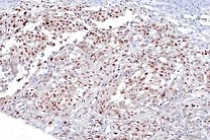ARG67043
anti-PRAME antibody [SQab30314]
anti-PRAME antibody [SQab30314] for IHC-Formalin-fixed paraffin-embedded sections and Human
Overview
| Product Description | Recombinant rabbit Monoclonal antibody [SQab30314] recognizes PRAME |
|---|---|
| Tested Reactivity | Hu |
| Tested Application | IHC-P |
| Host | Rabbit |
| Clonality | Monoclonal |
| Clone | SQab30314 |
| Isotype | IgG |
| Target Name | PRAME |
| Antigen Species | Human |
| Immunogen | Recombinant protein of Human PRAME. |
| Conjugation | Un-conjugated |
| Protein Full Name | Melanoma antigen preferentially expressed in tumors |
| Alternate Names | PRAME, PRAME Nuclear Receptor Transcriptional Regulator, CT130, MAPE, Melanoma Antigen Preferentially Expressed In Tumors, Preferentially Expressed Antigen In Melanoma, Preferentially Expressed Antigen Of Melanoma, Cancer/Testis Antigen 130, Opa-Interacting Protein 4, OIP-4, OIP4, Opa-Interacting Protein OIP4 |
Application Instructions
| Application Suggestion |
|
||||
|---|---|---|---|---|---|
| Application Note | The dilutions indicate recommended starting dilutions and the optimal dilutions or concentrations should be determined by the scientist. | ||||
| Positive Control | Human malignant melanoma |
Properties
| Form | Liquid |
|---|---|
| Purification | Purification with Protein A. |
| Buffer | PBS, 0.01% Sodium azide, 40% Glycerol and 0.05%BSA. |
| Preservative | 0.01% Sodium azide |
| Stabilizer | 40% Glycerol and 0.05%BSA |
| Storage Instruction | For continuous use, store undiluted antibody at 2-8°C for up to a week. For long-term storage, aliquot and store at -20°C or below. Storage in frost free freezers is not recommended. Avoid repeated freeze/thaw cycles. Suggest spin the vial prior to opening. The antibody solution should be gently mixed before use. |
| Note | For laboratory research only, not for drug, diagnostic or other use. |
Bioinformation
| Database Links |
Swiss-port # P78395 Human Melanoma antigen preferentially expressed in tumors |
|---|---|
| Gene Symbol | PRAME |
| Gene Full Name | PRAME Nuclear Receptor Transcriptional Regulator |
| Background | This gene encodes an antigen that is preferentially expressed in human melanomas and that is recognized by cytolytic T lymphocytes. It is not expressed in normal tissues, except testis. The encoded protein acts as a repressor of retinoic acid receptor, and likely confers a growth advantage to cancer cells via this function. Alternative splicing results in multiple transcript variants. [provided by RefSeq, Apr 2014] |
| Function | Substrate-recognition component of a Cul2-RING (CRL2) E3 ubiquitin-protein ligase complex, which mediates ubiquitination of target proteins, leading to their degradation.The CRL2(PRAME) complex mediates ubiquitination and degradation of truncated MSRB1/SEPX1 selenoproteins produced by failed UGA/Sec decoding. [Uniprot] |
| Cellular Localization | Cell membrane, Chromosome, Cytoplasm, Golgi apparatu, Membran, Nucleus |
| Calculated MW | 58 kDa |
| PTM | Phosphoprotein.[Uniprot] |
Images (1) Click the Picture to Zoom In






